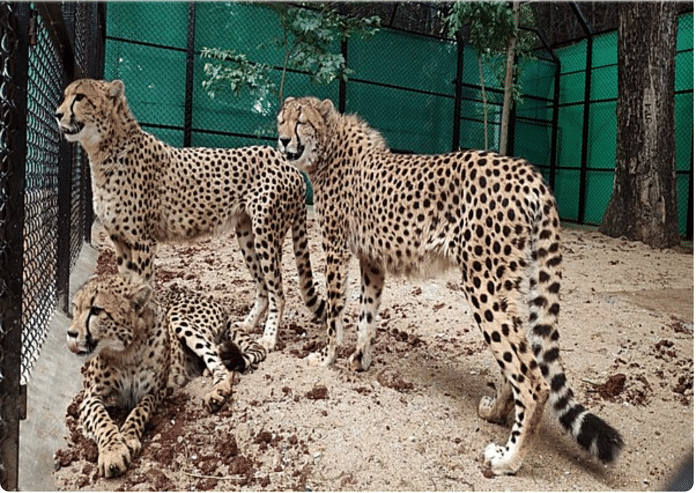New Delhi: Eight African cheetahs from Namibia will be introduced into a quarantining space in Madhya Pradesh’s Kuno National Park next week, to revive the species in India — nearly 72 years after it became extinct.
The cheetahs will first be kept in quarantine for 30 days, senior officials in the Ministry of Environment said Monday.
The eight cheetahs will board a chartered flight from Windhoek city and land in Jaipur on 16 September. They will be flown by helicopter to Kuno the next day to be released into quarantine by Prime Minister Narendra Modi.
The cheetahs will not be tranquilized, and will be accompanied by a team of three veterinarians, the officials said. India will get five female and three male cheetahs to begin with.
On 20 July, India and Namibia signed a Memorandum of Agreement (MoU) to introduce the African cheetah, 72 years after it went extinct here.
While the MoU has not been made public, a press release by the Environment Ministry said the “thrust” of the agreement lay in the “conservation and restoration of cheetah(s) in their former range areas from which they went extinct”.
An agreement with South Africa – which was supposed to send an additional 12 cheetahs – is still pending. A team of experts from South Africa visited Kuno National Park between 6 and 8 September, ministry officials said.
“The South African team will submit a report on their findings, after which they are likely to sign the agreement,” said S.P. Yadav, Member Secretary of the National Tiger Conservation Authority.
Yadav was speaking at an informal briefing on the introduction of the cheetahs, and was accompanied by Environment Minister Bhupender Yadav, Minister of State Ashwini Kumar Choubey, and Director General of Forests C.P. Goel.
The cheetah plan
After completing 30 days in quarantine, the cheetahs will be given a space of one square kilometre each within the prepared enclosure before being released into the wild.
The government said 35 to 45 cheetahs were required to establish a viable meta-population over the long term. After the initial batch of 8 cheetahs arrive, the population is expected to be supplemented by 4 to 8 animals every year for 5 years.
Based on prey-base estimates, Kuno National Park can support approximately 20 cheetahs, but “with restoration, protection and management, this number can go up to around 40 individuals,” according to a presentation by the government.
The cost of the entire exercise is Rs 91 crore.
“Cheetahs don’t normally attack humans, but they may attack cattle, so we have accounted for any compensation that might have to be paid because of that,” Yadav said.
Yadav added most leopards that were inside the enclosure were lured into cages and trapped, except for one leopard cub, which “will be removed before the cheetahs come”.
No lion translocation
Minister Bhupender Yadav said there was no plan to translocate the Asiatic lion at the moment. Kuno National Park had originally been cleared for the translocation of lions out of
Gujarat to diversify the animal’s habitat and protect against extinction.
The cheetah-introduction plan has received a lot of criticisms for this, since the translocation of the Asiatic lion – which was ordered by the Supreme Court in 2013 – has been sidelined because of this project.
Also read: Govt wants to drill for oil, gas in forest areas, but Wildlife Institute of India wary of new tech



